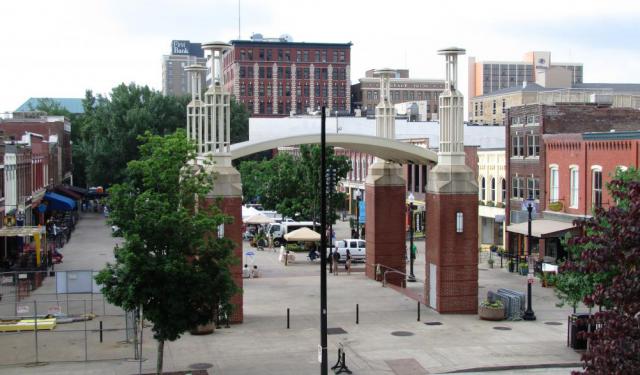
Emory Place Historic District, Knoxville
The Emory Place Historic District is an area in Knoxville, that has preserved its historical buildings and landmarks from the late 19th century. The district includes various types of buildings like residential, commercial, religious, and public ones that evolved around the train and trolley station. It comprises the Knoxville High School building, St. John's Lutheran Church, First Christian Church, and some rowhouses that still exist today. The area was listed on the National Register of Historic Places in 1994.
Emory Place's development started in the 1850s with the construction of railroads that expanded Knoxville northward. In 1890, the train station was established at Emory Place, attracting small industrial and commercial firms as well as a farmers' market to benefit from the customers and transportation benefits. The district declined after the dismantling of the trolley system in the late 1940s. However, many of its buildings have been preserved and restored.
The Emory Place Historic District is located in a triangular-shaped area formed by intersections of various streets, separated from downtown Knoxville by Interstate 40 and the Southern Railway tracks. The area was farmland until the establishment of Old Gray Cemetery in 1850 and the construction of the railway, which played a significant role in Emory Place's development.
The district comprises 23 contributing buildings and one object, the "Doughboy" statue on Knoxville High School's front lawn. The buildings in the district were constructed in the early 1900s, with the two oldest completed in 1890. The architectural styles include Colonial Revival, Neoclassical, and Richardsonian Romanesque.
Emory Place's development started in the 1850s with the construction of railroads that expanded Knoxville northward. In 1890, the train station was established at Emory Place, attracting small industrial and commercial firms as well as a farmers' market to benefit from the customers and transportation benefits. The district declined after the dismantling of the trolley system in the late 1940s. However, many of its buildings have been preserved and restored.
The Emory Place Historic District is located in a triangular-shaped area formed by intersections of various streets, separated from downtown Knoxville by Interstate 40 and the Southern Railway tracks. The area was farmland until the establishment of Old Gray Cemetery in 1850 and the construction of the railway, which played a significant role in Emory Place's development.
The district comprises 23 contributing buildings and one object, the "Doughboy" statue on Knoxville High School's front lawn. The buildings in the district were constructed in the early 1900s, with the two oldest completed in 1890. The architectural styles include Colonial Revival, Neoclassical, and Richardsonian Romanesque.
Want to visit this sight? Check out these Self-Guided Walking Tours in Knoxville. Alternatively, you can download the mobile app "GPSmyCity: Walks in 1K+ Cities" from Apple App Store or Google Play Store. The app turns your mobile device to a personal tour guide and it works offline, so no data plan is needed when traveling abroad.
Emory Place Historic District on Map
Sight Name: Emory Place Historic District
Sight Location: Knoxville, USA (See walking tours in Knoxville)
Sight Type: Attraction/Landmark
Sight Location: Knoxville, USA (See walking tours in Knoxville)
Sight Type: Attraction/Landmark
Walking Tours in Knoxville, Tennessee
Create Your Own Walk in Knoxville
Creating your own self-guided walk in Knoxville is easy and fun. Choose the city attractions that you want to see and a walk route map will be created just for you. You can even set your hotel as the start point of the walk.
Knoxville’s Historical Buildings
Knoxville is often referred to as "The Marble City" for the abundant supply of high-quality marble used in many of its buildings. Noting the wealth of well-preserved historic homes in the city, prominent American architect John Russell Pope even coined his own moniker for it – the "City of Houses".
Indeed, Knoxville's eventful and sometimes turbulent past, dating from... view more
Tour Duration: 2 Hour(s)
Travel Distance: 2.2 Km or 1.4 Miles
Indeed, Knoxville's eventful and sometimes turbulent past, dating from... view more
Tour Duration: 2 Hour(s)
Travel Distance: 2.2 Km or 1.4 Miles
Downtown Knoxville Walking Tour
A small town with big-city amenities and a vibrant music scene (a mix of country, bluegrass, and rock), Knoxville, or K-Town as it's popularly shortened by locals, is also often referred to as “the Gateway to the Great Smoky Mountains,” for its proximity to the national park area, whose marble quarries, in the past, gave it another moniker, The Marble City.
Knoxville was founded in... view more
Tour Duration: 2 Hour(s)
Travel Distance: 2.3 Km or 1.4 Miles
Knoxville was founded in... view more
Tour Duration: 2 Hour(s)
Travel Distance: 2.3 Km or 1.4 Miles
University of Tennessee Walking Tour
Founded in 1794 as William Blount College, The University of Tennessee (UT) in Knoxville is one of the oldest public universities in the United States. Nowadays, the UT flagship institution features a mix of historic and modern sites which draw many a visitor to the city.
The campus covers nearly 600 acres in downtown’s west end, including over 200 buildings and a faculty of more than 1,700... view more
Tour Duration: 2 Hour(s)
Travel Distance: 3.0 Km or 1.9 Miles
The campus covers nearly 600 acres in downtown’s west end, including over 200 buildings and a faculty of more than 1,700... view more
Tour Duration: 2 Hour(s)
Travel Distance: 3.0 Km or 1.9 Miles



